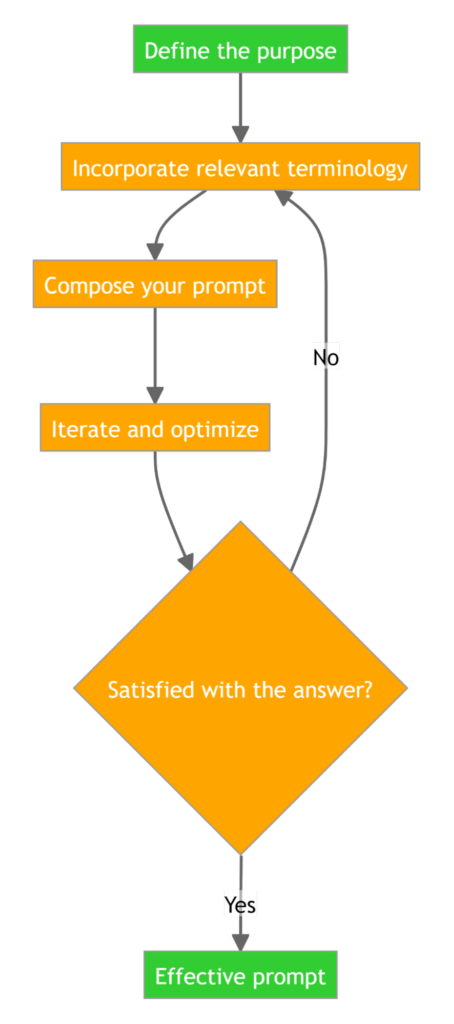As software engineers, we are constantly looking for ways to refine our interaction with artificial intelligence to optimize our ideation process and strengthen the quality of our results. This article dives into the art of prompt engineering —a critical skill for anyone working with natural language processing (NLP) models, such as StackSpot AI.
We’ll explore the different nuances of simple prompts, which are catalysts for rapid idea generation, and advanced prompts, which provide the framework for more elaborate and detailed responses.
Demystifying prompt engineering
At its core, prompt engineering is similar to creating a well-designed fishing lure; it’s about making clear, concise, and powerful prompts to extract the answers we’re looking for from AI models. The process combines art and science, requiring a keen understanding of how to communicate effectively with these sophisticated systems.
Fundamental principles of prompt engineering
To excel at prompt engineering, consider these fundamental principles:
- Specificity is critical: the more detailed your criteria, the more targeted the results provided by StackSpot AI.
- Incremental approach: work on your tasks in manageable, incremental segments for more precise results, mirroring your approach with another person.
- Iterative refinement: continually review your prompts, allowing the AI to improve its outputs progressively.
For more information and advanced strategies, check out our article on everything you need to know about prompt engineering!
Structured prompting methodology
When engaging with StackSpot AI, follow these steps to ensure clarity and precision:
- Define the purpose: articulate your goals and the type of response you are seeking from StackSpot AI.
- Incorporate relevant terminology: use industry-specific and topic-related terms to guide StackSpot AI to your desired answers.
- Compose your prompt: with your goal and terminology in hand, craft a prompt that concisely conveys the required information and tasks.
- Iterate and optimize: test your prompt with StackSpot AI, evaluate the results, and refine as necessary. Repeat this cycle until you consistently receive the desired responses.

Creating an effective prompt
The secret to eliciting optimal output lies in the interaction between the AI model’s training data, its parameters, and the quality of its prompts. Since our influence is most significant on the latter, we’ve outlined some characteristics of an effective prompt:
- Use language that is clear and concise, avoiding ambiguity;
- Define the persona for StackSpot AI, setting the stage for their role in your interaction;
- Provide rich information and examples to enhance StackSpot AI’s responses;
- Explicitly state the specific task you are asking StackSpot AI to perform;
- Keep in mind that you must refine your prompts based on the initial responses to achieve the desired result.
Example of an effective prompt
“As an experienced programmer with knowledge in [Legacy Programming Language] and [Modern Programming Language], as well as experience in application modernization, distributed architectures, and design patterns, it is essential that your code analysis and writing follow the guidelines below:
– Write clean, maintainable, testable, and reusable code.
– Avoid specific [Legacy Programming Language] elements that don’t adapt well to microservices.
– Implement detailed logging, exception handling, and field validation as required.
– Adopt microservices best practices from [Modern Programming Language], including SOLID principles.
– Use meaningful names for classes, fields, packages, etc.
If you understand and are committed to these goals, please confirm.”
The previous prompt aims to guide StackSpot AI to act as an experienced programmer, specifically tasked with modernizing a legacy program. The guidelines emphasize the need to generate code that is clear, maintainable, testable, and reusable, avoiding specific elements of legacy programming languages that are not well-suited for microservice architectures.
StackSpot AI must implement detailed logging, exception handling, field validation, and follow the best microservices practices in modern programming language, including SOLID principles. In addition, the tool is instructed to use meaningful names for code elements.
The final part of the prompt instructs StackSpot AI to confirm its understanding and ability to execute the modernization according to these guidelines.
Achieving prompt engineering mastery with StackSpot AI
Throughout this article, we’ve explored the vital importance of prompt engineering in maximizing the effectiveness of StackSpot AI. We learned that creating prompts is a technical task and an art form that requires clarity, conciseness, and a deep understanding of the desired goals.
Prompt engineering is a powerful tool that, when mastered, can transform how we interact with StackSpot AI. It allows us to extract precise and valuable answers that drive our software projects forward.
Specificity, an incremental approach, and iterative refinement emerge as critical principles for success. By applying these principles, we ensure that each prompt allows StackSpot AI to understand and meet our needs as accurately as possible. The structured prompting methodology we’ve outlined serves as a roadmap for achieving consistent, high-quality results.
Prompt engineering is an essential component of our toolkit as software engineers. By honing our prompting skills, we improve our efficiency and build new horizons for innovation and creativity in our interactions with AI.
With StackSpot AI as our collaborative partner, we are well-equipped to tackle the challenges of software engineering and achieve new heights of success.
Relevant links
- Learn how StackSpot AI can take your projects and skills to the next level!
- Explore our documentation to access complete guides and improve your technique using StackSpot AI.
- Questions? Visit our FAQ for a better understanding of our tool.
- Sign up for our newsletter to receive the latest news and best practices.
- Follow our YouTube channel for valuable tutorials, tips, and insights.

 Skip to content
Skip to content


